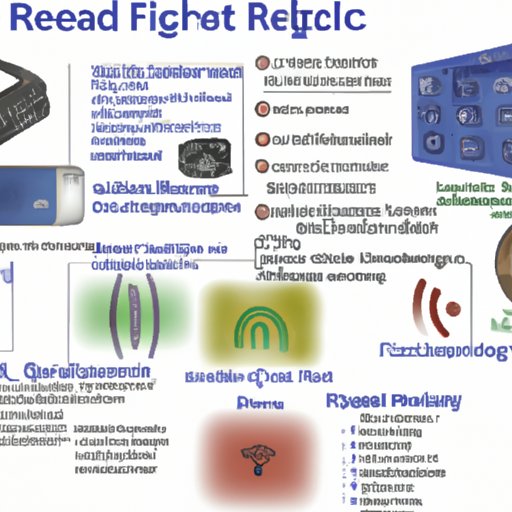Introduction to RFID Technology
Radio Frequency Identification (RFID) is a technology that uses electromagnetic fields to automatically identify and track tags attached to objects. RFID tags contain electronically stored information that can be transmitted via radio waves to a reader device. This technology has been around since the 1940s, but has recently become more popular due to its ability to quickly and accurately identify and track objects.
Definition of RFID and How It Works
RFID is a type of wireless technology that transmits data from an RFID tag or “transponder” to an RFID reader. The RFID tag contains a unique identifier that is encoded into the tag, which allows it to be identified and tracked by the reader. The reader then sends the information to a computer, which can be used to track and manage the object. This technology is often used in supply chain management, inventory tracking, asset management, and security systems.

Benefits and Applications of RFID
RFID technology offers many benefits over traditional barcode systems. It is faster, more accurate, and can store more information than barcodes. Additionally, it does not require line-of-sight scanning, allowing for better accuracy and fewer errors. RFID technology is also much more secure, as it is difficult to replicate or tamper with RFID tags.
RFID technology is applicable in a variety of industries and applications. For example, it is used in retail stores to track inventory and prevent theft; in healthcare to track medical supplies and patient records; and in transportation to track vehicles and cargo. It is also used in security systems to monitor access control and restrict entry to certain areas.

Components of an RFID System
An RFID system consists of several components that work together to identify and track objects. These components include RFID tags, RFID readers, antennas, and software. Each component plays an important role in the overall system and must be properly configured and integrated for optimal performance.
RFID Tags
RFID tags are small devices that contain a unique identifier and can be attached to objects. These tags are typically made of plastic or metal and are embedded with an antenna that transmits data to a reader. The tags come in different shapes and sizes and have various features, such as temperature sensors or GPS tracking.
RFID Readers
RFID readers are devices that receive data from RFID tags. They typically consist of an antenna, transceiver, and decoder. The antenna receives the signal from the tag, the transceiver converts the signal into digital data, and the decoder interprets the data and sends it to the computer.
Antennas
Antennas are essential components of an RFID system. They are responsible for receiving and transmitting the signal from the tag to the reader. Different types of antennas are available depending on the application and range required.
Software
Software is another important part of an RFID system. It is used to manage and analyze the data collected by the reader. Software can be used to generate reports, track objects, and automate processes.

Exploring the Different Types of RFID Technology and Their Uses
There are several types of RFID technology available for use, each of which has its own advantages and disadvantages. Active RFID tags are powered by an internal battery and have a longer read range than passive tags. Passive tags do not have an internal power source and rely on the reader to power them. Semi-passive tags have an internal power source and can transmit data back to the reader.
Each type of RFID technology has its own applications. Active tags are well-suited for asset tracking and monitoring, while passive tags are best for inventory tracking and access control. Semi-passive tags are often used in healthcare settings to track medical equipment and patient records.
Leveraging RFID Technology for Improved Efficiency
Companies can leverage RFID technology to streamline processes and increase efficiency. By using RFID tags to track assets, inventory, and personnel, businesses can reduce costs and improve productivity. Additionally, RFID technology can be used to automate processes and enhance security.
Advantages and Disadvantages of Using RFID Technology
Although RFID technology offers many benefits, there are some drawbacks. The cost of implementing an RFID system can be high, and the technology requires specialized knowledge and expertise to set up and maintain. Additionally, there are privacy concerns with RFID technology, as it can be used to track people without their knowledge.
Conclusion
RFID technology is a versatile and powerful tool that can be used to identify and track objects. It offers numerous benefits, including increased accuracy, speed, and security. Companies can leverage RFID technology to streamline processes, save money, and improve efficiency. However, it is important to consider the potential drawbacks, such as cost and privacy concerns, before implementing an RFID system.
Summary of Key Points
RFID technology is a type of wireless technology that uses electromagnetic fields to identify and track tags. It offers many benefits, such as increased accuracy, speed, and security, and is applicable in a variety of industries and applications. An RFID system consists of several components, including tags, readers, antennas, and software. Companies can use RFID technology to streamline processes and increase efficiency, but should consider the potential drawbacks, such as cost and privacy concerns.
Final Thoughts on RFID Technology
RFID technology is a powerful tool that can be used to identify and track objects. It offers numerous benefits and can be used in a variety of industries and applications. Companies can leverage RFID technology to streamline processes, save money, and improve efficiency. However, it is important to consider the potential drawbacks before implementing an RFID system.
(Note: Is this article not meeting your expectations? Do you have knowledge or insights to share? Unlock new opportunities and expand your reach by joining our authors team. Click Registration to join us and share your expertise with our readers.)
